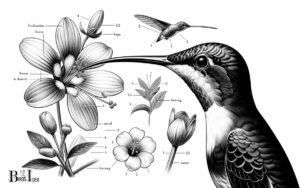Ruby Throated Hummingbird Range Map: Explore!
The Ruby-Throated Hummingbird (Archilochus colubris) has a range that primarily covers eastern North America, with its presence extending from Central America during the non-breeding season to Canada in the breeding season.
This species is known for its vibrant plumage and dynamic migration habits, which are detailed in the Ruby-Throated Hummingbird Range Map.
The Ruby-Throated Hummingbird Range Map illustrates the geographical areas where this species can be found throughout different times of the year.
Key components of the map include:
Explore the migratory marvel of the Ruby-Throated Hummingbird, captured through the detailed lens of the range map.

Key Takeaway
3 Seasons: Ruby-Throated Hummingbird Range
| Season | Range | Notable Locations |
|---|---|---|
| Breeding | Eastern North America | From Central Canada to Gulf Coast |
| Migration | Across Gulf of Mexico, Eastern US | Stopovers in coastal states, Mexico |
| Wintering | Central America, Southern Florida, Mexico | Costa Rica, Panama, Yucatan Peninsula |
Ruby-Throated Hummingbird Overview
The Ruby-throated hummingbird is a small, agile bird known for its iridescent green feathers and remarkable migratory behavior.
Measuring only 3 to 3.5 inches in length, this bird is a marvel of nature with its rapid wing beats, often compared to the humming sound of a bee. The male’s ruby-red throat patch, or gorget, is a distinguishing feature, while the female boasts a white throat and underparts.
These birds are predominantly found in eastern North America, from Canada to the Gulf of Mexico, favoring woodland edges, gardens, and meadows. Their diet primarily consists of nectar from tubular flowers, supplemented by small insects.
Understanding the Ruby-throated hummingbird’s lifestyle and habitat is crucial in comprehending its migration patterns, which are a testament to the species’ adaptability and resilience.
Migration Patterns
During migration, Ruby-throated hummingbirds travel thousands of miles. Their migration patterns are truly remarkable, showcasing their incredible endurance and navigational abilities.
Here are three fascinating aspects of their migration:
- Long-Distance Travel: These tiny birds embark on a daunting journey, covering around 500 miles non-stop over the Gulf of Mexico, a feat that requires substantial fat reserves for energy.
- Timing and Routes: Ruby-throated hummingbirds migrate alone, departing from their breeding grounds in late summer to early fall and traveling to their wintering grounds in Central America. They follow specific routes, with some flying along the Gulf Coast and others crossing the Gulf of Mexico.
- Wintering Grounds: During winter, they occupy a range from southern Mexico to Panama, where they find suitable habitats with ample nectar sources.
The remarkable migration of these birds sets the stage for their breeding range, which is equally fascinating.
Breeding Range
In the breeding season, Ruby-throated hummingbirds establish their range in eastern North America. This range spans from southern Canada to the Gulf of Mexico, covering a diverse array of habitats including deciduous forests, orchards, and gardens.
The eastern part of the United States, particularly the area east of the Mississippi River, serves as the primary breeding ground for these hummingbirds.
They are known for their remarkable ability to adapt to various environments within this range, from coastal marshes to inland woodlands.
These adaptable birds primarily breed in open woodlands, along streams, and in gardens with ample floral resources.
The availability of suitable nesting sites and abundant nectar-producing flowers plays a crucial role in determining the precise locations within their breeding range where these hummingbirds establish their nests.
Wintering Locations
With the end of the breeding season, Ruby-throated hummingbirds migrate to wintering locations in Central America and southern Mexico. During the winter months, these tiny birds seek out specific habitats that provide suitable conditions for their survival.
Three key aspects of Ruby-throated hummingbird wintering locations include:
- Tropical Forests: The hummingbirds rely on the abundant nectar sources found in the diverse flowering plants within the tropical forests of Central America and southern Mexico.
- Mild Climate: These wintering locations offer a favorable climate with relatively stable temperatures, allowing the hummingbirds to conserve energy and maintain their metabolic needs.
- Migration Patterns: The birds follow specific migration routes, often crossing the Gulf of Mexico, to reach their wintering grounds, where they will remain until the return of spring prompts their northward journey.
Habitat Preferences
Seeking out diverse flowering plants, tropical forests play a crucial role in the habitat preferences of Ruby-throated hummingbirds during their wintering period.
These birds are primarily attracted to areas abundant in nectar-producing flowers such as trumpet vines, bee balms, and red salvias. The dense foliage of the tropical forests provides shelter and nesting sites, offering protection from predators and adverse weather conditions.
Additionally, the presence of insects in these habitats serves as a vital protein source, supplementing the hummingbirds’ nectar-based diet.
The availability of water sources, such as streams or rivers, further contributes to the suitability of tropical forests as wintering grounds for these birds.
The interconnectedness of these elements within the tropical forest ecosystem provides an ideal environment for Ruby-throated hummingbirds to thrive during the winter months.
Conclusion
The ruby-throated hummingbird’s migration patterns, breeding range, and wintering locations are influenced by its habitat preferences.
The bird’s movements can be likened to a delicate dance, as it navigates through various landscapes with precision and grace.
As it flits from one location to another, the hummingbird’s range map reveals a remarkable journey, demonstrating the resilience and adaptability of this tiny, yet mighty, creature.






